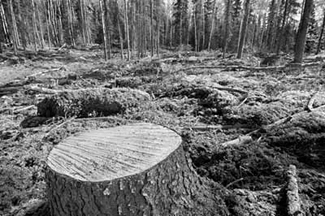|
Reducing Emissions from Deforestation and forest
Degradation (REDD):
Preserving tropical forests the world over
by Patali CHAMPIKA RANAWAKA
The United Nations Climate Change Conference will be held in
Copenhagen, Denmark between December 7-18, 2009. There are signs of this
summit generating some awareness of climate change related issues among
Sri Lankans as well. Some Sri Lankans have met me and also have sent
e-mails to enlighten me about their innovations on carbon emission
mitigation and adaptation possibilities. One enthusiast from Homagama
had come up with the idea of breeding molluses in deep sea bed to
facilitate absorption of excessive carbon. Another young man had come up
with some ideas of capturing industrial and vehicular carbon emissions.
 One Sri Lankan expatriate has already got a patent for his submission
for carbon negativity using rubber plantations. As rubber is basically
composed of carbon and water, the rubber tree can be used as a magic
tree to sink green house gases. When I met with rubber research
institute people, I found that Sri Lanka has over 146,000ha, of
dedicated monoculture rubber plantations and every hectare of it absorbs
10 tons of carbon annually. That means it simply stores or sequestrate
over 1.4 million tons of carbon annually. One Sri Lankan expatriate has already got a patent for his submission
for carbon negativity using rubber plantations. As rubber is basically
composed of carbon and water, the rubber tree can be used as a magic
tree to sink green house gases. When I met with rubber research
institute people, I found that Sri Lanka has over 146,000ha, of
dedicated monoculture rubber plantations and every hectare of it absorbs
10 tons of carbon annually. That means it simply stores or sequestrate
over 1.4 million tons of carbon annually.
In Sri Lanka burning of fossil fuels emits 12 million tons of carbon
annually. (600kgs per-capita carbon emission). Therefore, these rubber
plantations alone neutralize 10% of the fossil fuel emissions. If we
take the other protected forests over 1.4 million ha, along with other
Sri Lankan forests, monoculture plantations and green canopy, it would
act as carbon sinks and thereby mitigate the whole Sri Lanka carbon
emissions. If that is the story, why are these plantations and forests
not qualifying for being rewarded in carbon trading business?
It has been reported that nearly 18% of the global carbon emission is
due to deforestation or forest degradation. In many of the so called
under developed or developing countries, the primary energy is supplied
by fuel wood and in Sri Lanka it is nearly 48% of the total energy.
Household and industries still extensively use fuel wood as their
indigenous energy source and in some countries it is over 99%.
At the very beginning of the climate change discussions,
deforestation was identified as one of the key contributors of the
carbon emissions.
Therefore, some rewarding mechanism was proposed for aforestation and
reforestation, Reducing Emissions from Deforestation and forest
Degradation (REDD) was introduced. If you replant a forest on bare land
which has been deforested for a period of 50 years or more, you are
qualified for an aforestration scheme. Whereas, if you replant a bare
land which has no trees since 1989, you are qualified for a
reforestation scheme. Although, according to the present market
conditions you are able to get carbon credits, there is no mechanism to
get rewarded for not deforesting. Avoiding deforestation is less likely
to be benefitted. This will pave the way for deforestation and
thereafter reforestation of the same lands. It simply means you have to
cut trees and replant to get rewarded in this carbon trading scheme.
Later-on forest degradation too had been taken into account.
Generally a forest is defined as a cluster of trees which has 70% or
more crown cover. Anything below that level is defined as a degraded
forest. Now it has been identified that forest degradation is a major
source of green house gases.
 |
|
A path in a New Zealand
rain forest. |
In year 2003, rain forest coalition was formed in New York and a new
mechanism in reducing emissions from deforestation and forest
degradation (REDD Plus) was introduced, taken into account that avoiding
deforestation should also be included in the scheme.
At the last UN general session, there was a UN sponsored REDD
convention where I met its current president (from Papua New Guinea) and
formally submitted our intention to join the Rainforest Coalition.
It is an inter governmental organization set up with the help of
Indonesia which pioneered the move to protect tropical forests and we
finally managed to get its membership. When our UN permanent
representative Dr. Palitha Kohona informed me about our achievement, I
was very proud specially due to the fact that in year 2000, the then
government tried to exchange our rain forests, such as Singharaja for
our financial debts to USA. I was the only Member of the Parliament
(representing Sihala Urumaya) who revealed that betrayal and was
instrumental in saving our rainforests. These developed countries who
achieved their development using fossil fuels, tried to offset their
emission by controlling the tropical forests of other countries. (That
could be one reason)
As adopted at COP 9 in 2003, forest degradation is defined as direct
human - induced long term loss of forest carbon stocks. Common degrading
activities in the tropics include selective logging, large scale and
open forest fires, collection of fuel wood and non timber forest
products. The production of charcoal (black carbon), grazing, sub canopy
fires, shifting cultivations etc.,
There is a curve called forest transition curve according to which
four categories of countries could be identified. (see pic) this forest
transition curve reflects the dynamics of agriculture and forest trends
over time. Using this curve we could identify the gravity of the
deforestation and degradation of forest, thereby measuring and
monitoring of losing biomass of the particular country could be
evaluated.
The four categories are, Countries and regions with low deforestation
and high forest cover - such as Congo and Guyana, their forests are
relatively undisturbed.
Countries and regions with high deforestation such as Brazil,
Indonesia and Ghana.
Countries with low deforestation and low forest cover like India,
Pakistan and North African countries.
 Countries with increasing forest cover such as China and Vietnam. Countries with increasing forest cover such as China and Vietnam.
Earlier countries that belong to category 4 above - increasing forest
cover, was only able to benefit from aforestation and reforestation
mechanisms. But using REDD Plus mechanisms which tried to avoid moving
into category 1 to 2 and category 2 to 3 could also get benefits.
Theoretically, if we could be able to avoid that movement via forest
transition curve, it seems we could reduce emission by 18%.
But this is not a simple task as some enthusiastic propagators of
REDD Plus formula suggest. Because one third of the world population
extensively use wood as their primary energy source. So, without giving
them an alternative energy source no one could be able to stop the
trend. In their recent report, “Development and Climate Change” the
World Bank suggests another alternative. If the population of the USA
could simply switch over from their SUV’s to fuel efficient passenger
cars with EU fuel economy standards, that alone will offset the
emissions generated in providing electricity to 1.6 Billion around the
world without access to electricity.
Institutional arrangements
Between April and September 2009, the forest dialogue held four
international dialogues. There, they identified five core areas, namely
underpinning principles, phased approach, financial architecture,
monitoring, reporting and verification and financial assurance.
In summary, there are four underpinning principles
REDD Plus finance mechanism should be sufficiently robust to deal
with in country and international leakage use credible baselines must
achieve variable addition and resulting value for money.
REDD Plus should lead to real reduction of carbon dioxide enhanced
forest eco system functions and the supply of critical eco system
services, protect and respect the rights of indigenous people and local
community and ensure equal benefit sharing.
In addition to reducing emissions from deforestation and forest
degradation REDD Plus finance mechanism should also create incentives
for additional action in forest conservation, sustainable forest
management and the enhancement of carbon stocks.
REDD Plus process should allow the broad participation of all
stake-holders on equitable terms at the National and International
levels.
(Executive summary - Sep.2009)
It was also suggested that REDD Plus oversight body with technical,
financial and administrative responsibilities should be setup under the
Conference of Parties to the UNFCCC with representation based on United
Nations regions using the nine major groups structure under the ECOSOC
frame work.
 Whatever the reason maybe, there should be a market mechanism to
value and reward forests for their environmental services. One such
important functional service is to absorb, stock and sequestration of
carbon. We cannot expect that all the carbon released by burning of
fossil fuel could be absorbed by forests and green cover of the eco
system. Because releasing of geological carbon (fossil fuel) is much
more than absorbing ability of biological carbon sinks - forests. But it
could be used as a natural storage of carbon by paying for the services
it rendered. REDD Plus program is trying to introduce that kind of new
financial mechanism which could be a real benefit to tropical countries
which have tropical rainforest like Sri Lanka. Whatever the reason maybe, there should be a market mechanism to
value and reward forests for their environmental services. One such
important functional service is to absorb, stock and sequestration of
carbon. We cannot expect that all the carbon released by burning of
fossil fuel could be absorbed by forests and green cover of the eco
system. Because releasing of geological carbon (fossil fuel) is much
more than absorbing ability of biological carbon sinks - forests. But it
could be used as a natural storage of carbon by paying for the services
it rendered. REDD Plus program is trying to introduce that kind of new
financial mechanism which could be a real benefit to tropical countries
which have tropical rainforest like Sri Lanka.
The writer is the Minister of Environment and Natural Resources
|

